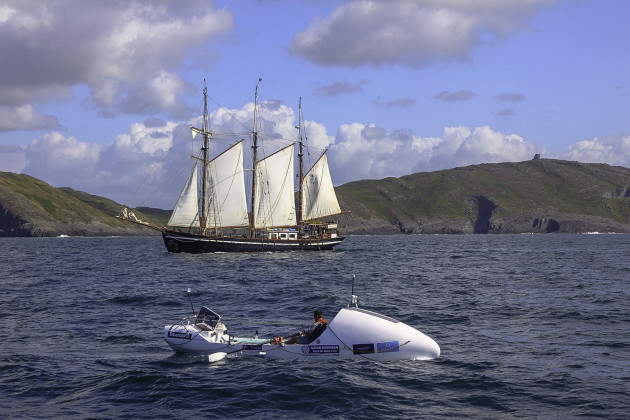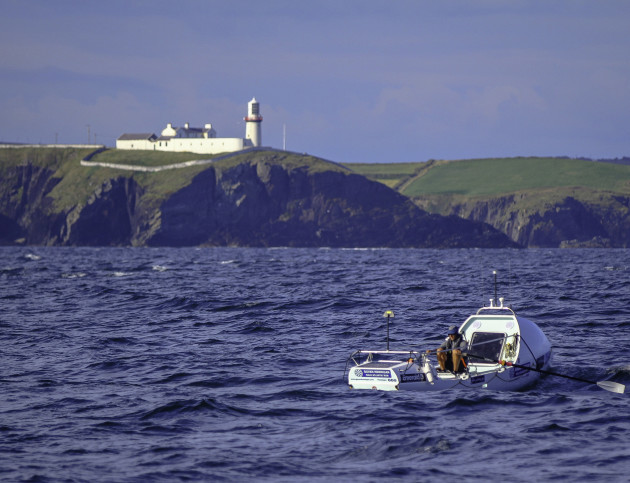WHEN WE LAST met Galway native Gavan Hennigan, he had just posted the third fastest time in the history of the world’s coldest adventure race — the Yukon Arctic Ultra – running 300 miles in five days on six hours of sleep in -30 Celsius.
To help recover, he set off on an expedition along Lake Baikal in Siberia in March.
At 636km long, it is the oldest and deepest lake in the world and Hennigan became one of just a handful of people to complete a solo traverse of it.
gavkm27 / Vimeo
For most people, that’s more than enough to pack into a year.
But for Hennigan, there’s always another adventure around the corner and this time he has set his sights on The Talisker Whisky Atlantic Challenge, a 5,556km row across the Atlantic.
First held in 1997, the challenge is widely regarded as the world’s toughest rowing race and this year will see 15 boats — ranging from solo rowers to four-person teams – race from the Canary Islands to the West Indies.
For Hennigan, the race represents another opportunity to make the most of the second chance he’s had at life, following struggles with alcohol, drugs and his mental health that resulted in a trip to rehab and a suicide attempt at the age of 21.
“I had a lot of trouble with my mental health and I was drug-addicted in my late teens and early 20s and tried to take my own life at the age of 21,” Hennigan told The42 this week.
“I’d a really tough time but I’ve had a lot of help over the years and Jigsaw Galway (alongside Cancer Care West, one of the two charities Hennigan is racing funds for) are doing great work so it’s nice to be able to support them but also demonstrate what’s possible with a bit of self-belief and mental resilience.”
While Hennigan doesn’t see himself as a spokesperson for mental health, he does think it’s important to be part of the coversation.
“I think it’s good for people to be able to hear stories like mine, someone who came from the brink of suicide to be able to go out and do the crazy events I’m doing.
“I started drinking like most normal teenagers but I have an addictive personality and I suppose I took it three steps too far and I ended up in rehab at 21. I was in a pretty dark place.
“Not long after that I tried to take my own life. A lot of it was due to the fact I’m gay and I had a lot of self-hatred because I couldn’t come to terms with that.
“But that’s why this row is really important to me because of what I’ve been through. Having gotten a second chance after coming out of rehab and from the brink of taking my own life, I’m determined to make the most of it.
“It makes it all a little bit more pertinent for me, to know that I’ve come from that place and now I’m challenging myself to do these big events.
I’m sharing my story so that anyone, but particularly a younger person who is maybe struggling with their identity or with their mental health, can see there is hope.
“Don’t get me wrong, I’m going out to do this as a challenge for myself first and foremost because I get still get a buzz from the adventure, but it’s important to have these conversations around identity and mental health.”
Much like you never run 26.2 miles while training for a marathon, the now 35-year-old Hennigan had to find ways to adapt his training to build himself up — mentally and physically — for the challenge without burning himself out.
This involved a lot of time in the gym and rowing up and down the west coast of Ireland, something Hennigan says was potentially more dangerous than the race itself.
“The furthest I’ve rowed to date was when I went from Castlegregory on the Dingle Peninsula to Galway a couple of weeks ago,” he says.
“I was actually waiting for some stormy conditions and I was about 20 miles offshore — off the coast of Clare — and that was pretty hairy.
“I think coastal rowing is probably more dangerous in a lot of ways than ocean rowing because the boat isn’t that manoeuvrable and you’re dealing with tides, winds and obviously the Clare coastline which is mainly cliffs so navigation becomes a bit harder.”"
That’s not to say there are not risks involved with the race itself. Indeed, Hennigan is only too familiar with what can go wrong after talking to Ireland’s only other solo competitor.
“There have been lots of Irish rowers who have competed as part of teams but there was only one other solo racer.
“Seán McGowan did it back in 2010. It took him 118 days. I contacted him when I first considered doing this race and he has quite a story to tell.
“The first thing he actually said to me was that nothing you can do will prepare you for what it’s really like out there and you just have to get used to being afraid all the time… which is obviously terrifying,” he laughs.
“Seán had a pretty harrowing story, he broke all his oars so that’s how it took him 118 days. I definitely want to do at least half that. Having spoken to him, what he went through really made me sit up straight and take my preparation seriously though.
“The biggest risk is obviously storms. Last year they were hit by three big storms and the entire fleet was kind of knocked about during the race. You have this low pressure system that tracks really far south and sweeps right through the section of the Atlantic that we’ll be rowing in.
“When it gets bad, you’re not able to row so we have this thing called a parachute anchor or sea anchor. It’s just this massive 12ft parachute that goes off the bow and sinks down underwater and not only stops you from moving backwards but stabilises the boat too and you just wait until it’s over.
“I bought myself a scrum cap the other day so I didn’t have to bring my climbing helmet with me. It’s just to protect me if I’m being thrown around the boat. I have some of that children’s foam play-mat stuff that clicks together so I’ve used that to pad out the bulkhead so I’m comfortable enough.
“The boat’s going to be moving around a lot but I’ve made myself almost this little coffin that’ll keep me in the corner when I’m trying to sleep.”
If Hennigan does get into trouble at sea, there is a great deal of support for participants in the race, even if the vastness of the Atlantic Ocean could make its arrival a matter of days rather than hours.
While he’ll have GPS and radio and two satellite phones to help keep in touch with people, there is one piece of equipment that will be especially important:
“There’s a system on the boat called Automatic Identification System (AIS) and anyone who sails, or is involved with shipping, will be familiar with it. It shows up any other boats that are within 10 nautical miles of me and I’ve an alarm that will go off.
“That lets me know that there’s not just another vessel in the area but the name of it, the speed of it, the heading it’s on and will let me know if we’re on a collision course.
There’s a good chance I could encounter a large shipping container. They’ll be able to see me on the chart plotter but they couldn’t visually see me. I can get on the VHF radio, call their name, identify myself, let them know that I’m an ocean rowing boat moving very slowly and they’ll avoid me… hopefully!”
When you’re out at sea for as long as Hennigan will be, planning is of utmost importance to the extent that his thinking time is almost as important as his rowing time.
He also has to fight the temptation to row for 12 hours straight.
“Between each two-hour rowing stint, I’ll have to manage the navigation and deal with the weather to the most favourable course.
“I also have to make fresh water from seawater which runs off solar panels so I’ve to manage that and make sure the power is working correctly. If I find out it’s going to be cloudy for a couple of days, I’m going to need to take that into account too.
“I also have an autopilot that keeps the boat on the heading I want but that draws an awful lot of power as you can imagine so I have to be conscious of all these little things every single day.
“Sitting down and just rowing is probably going to be the easy part.”
The boat — pictured above — will ship to the UK on Tuesday before going on to the start line in the Canaries. Despite its size, it’s incredibly light, something Hennigan hopes will give him an advantage in the race.
“The boat is 150kg with nothing in it and just under 7m long. There are obviously going to be teams of two, three and four but they’ve to carry the weight of the people not rowing. I’ve got a light set-up and I think that’ll help me.
“As long as I do things tactically well, I think I’ve a good shot of doing well.
“I’ve sacrificed a huge amount for this row. I’ve basically quit my job, spent my entire life savings on this carbon fibre rowing boat and am putting it all on the line for this race so I really want to go out there and try to, not just complete it, but be competitive and challenge in the race as well.”
The Talisker Whisky Atlantic Challenge gets under way on 14 December and you can follow Hennigan’s progress on his Twitter and Instagram accounts, as well as his website where you can also make a donation to Jigsaw Galway and Cancer Care West.
If you need to talk, contact:
- Samaritans 116 123 or email jo@samaritans.org
- National Suicide Helpline 1800 247 247 – (suicide prevention, self-harm, bereavement)
- Aware 1800 80 48 48 (depression, anxiety)
- Pieta House 01 601 0000 or email mary@pieta.ie – (suicide, self-harm)
- Teen-Line Ireland 1800 833 634 (for ages 13 to 19)
- Childline 1800 66 66 66 (for under 18s)



